-
Posts
453 -
Joined
-
Last visited
Content Type
Profiles
Forums
Blogs
Gallery
Events
Store
Posts posted by redeagleorder
-
-
Lovely bars.
Offhand I'd say the first one is to a Bavarian, judging by the placement of the MVO4X ahead of the EK. Must have enlisted just before the war (no 1911 Luitpold Jubilee Medal) and was commissioned into the officer ranks just before the war's end, thus having accrued enough service time for the long service medal (war years counted double).Regarding the second bar, it seems slightly odd that the bar itself has a crown and swords device on it, but the MVK2X itself has no crown; possible switched at some point in the past? Also strange of two Bavarian long service awards, particularly when the 24-year one comes behind the 9-year one. Construction from the front however looks good. Is the Luitpold Medal the 1905 or 1911 version?
0 -
Beautiful example of a rare award Wild Card.
I would be very interested in discovering where the figure of 16 awarded to women comes from? As I recall, the award figures for this decoration are a subject of some debate, ranging from double digits to the low hundreds. Has a medal roll been discovered and/or published?
The reason for my interest is that I own a medal bar - shown here - with this Oldenburg decoration alongside the Schwarzburg Anna-Luisen Verdienstzeichen, the latter being bestowed solely upon women. I have always held out a faint hope that such a unique combination of rare awards may one day prove identifiable to the original recipient.
Kind regards
PS: Incidentally, my example is also hallmarked on the back with what looks to be a 950, although I do not have it in hand to check. Examples without hallmarks are also seen - apparently production varied between bronze gilt and silver gilt.0 -
An award I have been after for a considerable period of the time; Sachsen Meiningen's Kreuz für Verdienste in Kriege on the non-combatant ribbon. As per Rick Lundstrom and Daniel Krause's rolls, there were between 650-680 such awards.
This completes my Sachsen-Meiningen trilogy of non-combatant awards, taking its place alongside the Medaille für Verdienste in Kriege on non-combatant ribbon (shown previously in this thread) and the Kreuz für Verdienst von Frauen und Jungfrauen on ladies bow.
Another recent acquisition - a three-place medal bar with campaign awards in steel for the war of 1870 and, more notably, the Second Schleswig War. Still looking for the non-combatant campaign awards for 1848 and 1866.
Finally, a nice little bar also with the non-combatant campaign medal in steel for 1870, but on the combatant ribbon. (ironically for stay-at-homes, never understood the logic behind that one!).
1 -
Indeed Vince - although very similar to the ribbon meant for the "Kriegserinnerungszeichen des Bayerischen Landesvereins vom Roten Kreuz", the silver stripes on this examples are narrower and more reminiscent of the Bulgarian ribbon.
It would not surprise me if Bulgarian ribbon was more readily available during the early Weimar period than the award's intended ribbon. The medal itself is tied down with black ribbon in the exact same manner as the other two.
Another medal bar to recently come my way; the Wilhelmskreuz is the version with the blank reverse rather than the type with the 'kriegsverdienst' inscription. Can anyone highlight the exact reasons as to why a blank-reverse version was issued?
0 -
-
Looks like the Hohenzollern ribbon is the full-size version folded on itself over the middle black stripe?
0 -
-
Can anyone shed some light on why this bar has an officer's peacetime Saxe-Ernestine Order but only an enlisted man's SCG War Medal for WW1?
0 -
Perhaps the obituary is referring to the Kriegsverdienstkreuz awarded by the state of Lippe-Detmold, which was gold in colour and mostly awarded for combat. More information at https://www.ehrenzeichen-orden.de/deutsche-staaten/kriegsverdienstkreuz-1914.html
Regards,
Matthew
0 -
It's fine as it is - plenty of German soldiers served in the Great War and received no recognition for it. He could have been a recalled veteran or even a long-serving soldier who chose to retain the old brooch style of long service award.
I have never understood this argument that any Cross of Honour with swords on a medal bar with no other WW1 awards should be called into question - there are innumerable examples of genuine medal bars like this. I myself used to have a two-place medal bar with a Bronze China and Cross of Honour with swords - perfectly original.
Plus, the mounting style, while indeed hook-back, is not in the common pre-WW1 - if anything the ribbon furlings make it look Bavarian, as jeffskea noted.
0 -
On 19/02/2019 at 20:01, drspeck said:
Could the last one also be the Baden Verdienstmedaille?
Impossible - a Baden Verdienstmedaille would only have been awarded to other ranks. RAO3's would have been awarded to relatively senior officer ranks.
0 -
On 09/01/2019 at 14:26, laurentius said:
Dear redeagleorder
I don't think there has to be a Centenary medal with it, often a prussian LS award is combined with a Centenary award, but not always. If the owner of this LS award joined in 1898 and retired in 1920 he would have 22 years of service plus 4 years (war service counts double) and he would have his LS award, and no centenary. Taking part in the world war is also not a guarentee for a decoration. Only a third of the germans troops in WW1 got an iron cross.
Kind regards, Laurentius
Dear Laurentius,
I am aware that it would have been possible to qualify for the 25 year service cross without the Centenary Medal in the fashion you have described, and that not all German soldiers qualified for war medals. However, in the case of an officer, with a considerable length of pre-war service, no war decorations over four years would have been somewhat unusual.
Nonetheless, although without pictures it is impossible to confirm, I would have little doubt in the item being original (if nothing else, fakers surely have better things to do than fake single mounts for relatively common medals). He could indeed have drawn the short straw and missed out on any other awards in his career, or perhaps he was a career sergeant who was bumped up to officer rank in the waning days of the war.
On 08/01/2019 at 21:36, rabaduex said:Saw a single mounted 25 year Prussian service medal gilded bronze pinback on a dealer's site. Isn't this unusual for the veteran to mount just this award and wouldn"t he have some other medal during his service?
Dear rabadeux,
Could you clarify your use of the term 'pinback'? Are you referring to the needle arrangement on the back of the single mount or something attached to the medal itself? If the latter, it cannot be the same medal you describe, unless it has been heavily altered.
0 -
With a 25 year service award I would expect at least a Centenary Medal to go with it.
0 -
Truly spectacular medal bar!
0 -
17 hours ago, GreyC said:
Looks like the Saxon Ehrenkreuz für freiwillige Krankenpflege im Frieden? The one that I know has a red circle instead of blue, though. Is the blue one the one for wartime?
Hello GreyC,
The award you are referring to, founded in 1912, was indeed awarded only during the brief period between its founding and the outbreak of the Great War, and is consequently very rare. Once war broke out, the enamel on the front was changed to blue in colour, and the enamel on the back depicting a red cross on a white background removed. In the place of the latter were put a couple of dates, the first always 1914 and the second any one of 1915, 1916, 1917 or 1918. The ribbon was also changed to the version shown in the above photograph and medal bar. The award was renamed a couple of times during the war, finally ending up as the 'Ehrenkreuz für freiwillige Wohlfahrtspflege im Kriege'. An excellent website explaining these changes and providing examples was sachsens-orden.de, however it no longer seems to be available.
With regards to the Mecklenburg knopfloch and related ribbon bar, one of the Mecklenburg ribbons may represent the award of the Mecklenburg-Schwerin Friedrich Franz Alexandra Kreuz, awarded on this ribbon during the Great War for medical services rendered. Although award numbers were low, it would certainly be in keeping with the medical theme of the rest of the ribbon bar.
0 -
18 hours ago, ixhs said:
I like the Waldeck bar but the price was really crazy.
Note that normally the war aid cross war worn on pos. 2. - not 3. - your location is Malta - are you Wolf of the W.A.F.?
I am nearly sure, that the shown Frackspange of Gensui was worn by a marine guy - and a Ingenieur (officier´s grade)
It fits with the HHC and the Oldenburger on combatant ribbon. I think no paymaster - i`ve seen a lot of that guys with AEZ silver or bronce and sometimes with KO4 because they started as Mannschaftsgrad.
The most IC non combatant bars were worn by military officials and industrial guys - not by medics. (only if they served on the home front)
Markus B. has a lot of navy data.
Hello ixhs,
Yes the Waldeck bar's price was a bit stiff - I wasn't prepared to go much higher. However, it's the first Friedrich Bathildis Medaille I have ever seen for sale mounted in my years of collecting non-combatant bars, and was thus a 'must have'. A lot of non-combatant awards founded by various Imperial German states during World War 1 are priced in catalogues and price guides in a manner that in no way reflects their true rarity.
With regards to your second point, I imagine that due to the very limited numbers awarded (for context, a Great War Pour le Merite is twice as common) the vast majority of awarded Friedrich Bathildis Medailles went to native Waldeckers. I thus do not find it strange that it is mounted before the Kreuz fur Kriegshilfdienst on the bar.
No I am not 'Wolf' on the Wehrmacht Awards Forum - I did not even know of his existence until you mentioned him.
Although I am sure that it is no more than a typo on your part, the Oldenburg Friedrich August Kreuz on the medal bar shown here by Gensui (which is by the way a very nice specimen) is actually mounted on the non-combatant ribbon.
On 27/12/2018 at 19:07, Paul R said:Beautiful bars. I love the medals sewn onto the ribbon bar.
Hi Paul,
Thank you for your comment - one of my favourite medal bars too ?
I neglected to mention in my post that the medal bar must have belonged to a female doctor or nurse, as the Schwarzburg award was only awarded to women. It is indeed strangely mounted - a factor I ascribe either to the wearer being 'unwilling' for reasons unknown to wear a court-mounted medal bar as men did, or perhaps the difficulty of court-mounting the two centre medals due to their high oval shape.
On 22/12/2018 at 19:21, Stogieman said:Wonderful bars!
Thank you Stogieman - much appreciated!
0 -
My favourite thread on the forum - perhaps it is time to add a few decorations which have not yet been shown in here.
First up: Saxe-Altenburg Herzog Ernst Medaille mit Bandschleife 1914.
Number of awards: 1091 (710 to males).
Saxe-Meiningen Medaille für Verdienst im Kriege am Nichtkämpferband
Number of Awards: 326 (Rick Lundstrom’s rolls)
Hesse-Darmstadt Militärsanitätskreuz 1914 am Nichtkämpferband
Number of Awards: Unknown, but certainly rarer than its counterpart awarded on the ‘kriegsband’.
Waldeck Friedrich-Bathildis Medaille
Number of Awards: Figures vary. It seems undisputed that a total of 375 medals were manufactured, but the actual number awarded is variously cited as 306, 313 or 315. Awards to males (who are most likely to have worn decorations on a bar) are cited as either 140 or 141.
This particular example is an original award piece, with the designer’s name (R. Kowarzik) under the bust. Due to the medal’s inconvenient suspension (akin to that of Baden’s Verdienstmedaille), spangenstueck versions of this medal with a normal ring suspension can be found.Oldenburg Rote Kreuz Medaille & Schwarzburg Anna Luisen Verdienstzeichen
Number of Awards: Various numbers are given for the former, ranging from the low double figures (implausible considering the number seen on the market) to the low hundreds. Awards of the Anna-Luisen Verdienstzeichen stand at 215.
I believe I have shown this bar before on the forum, but the pictures seem to have disappeared.
0 -
I'm a bit late to this thread, but it would be great if we could have some further discussion on this medal. I too have an example of this on a medal bar, and the back is stamped with the same silver mark as in the opening post of this thread. A cursory search on google images shows the backs of four of these medals, only one of which is marked in a similar fashion.
Does anyone know why the discrepancy in materials used for an award which was bestowed in such low numbers? Was the bronze version awarded first and the award later made out of silver? Is this plausible in light of a wartime economy, when other awards that had been using precious metals were now being made out of cheaper materials? Furthermore, does anyone know the true number awarded - figures range from 18 (which seems absurdly low, considering there is at least half that number thrown up in a quick google search) to a few hundred?
Lars - on the examples that I've seen for this medal, in most cases the ribbon's red stripes seem to be narrower than those on the ribbon of the Friedrich August Kreuz and House Order.
Regards,
Matthew
0 -
Judging by the other two medical awards on the bar, one of those ribbons could conceivably represent that award of Mecklenburg-Schwerin's Friedrich-Franz-Alexandra Kreuz. Would certainly be a rare example if so.
0 -
The fifth ribbon could be one of the numerous bravery awards from Bulgaria during the First World War, and the ribbon in the last place is likely to represent the Russian Medal of Zeal or one of the associated Russian orders.
0 -
Hmmm... my most plausible choice would be...
1.) Iron Cross 2nd Class - no real other choice here
2.) Bavarian Military Merit Cross 2nd Class with swords - this is where it gets interesting. With regards to the 3rd class of the cross, those were actually not to commonly issued on the beamtenband - and I think that the 1st class would be too much of a stretch for someone with no Bavarian long service award. The medal would appear to have hung at the same height as the others, so that would exclude the possibility of a crown. I suppose it could be a Military Merit Order 4th class... but my gut feeling would be to go for the former.
3.) Hindenburg Cross: Even if it wasnt already hung there, very little other plausible choice.
4.) 1911 Luitpold Medaille: Once again, I think the lack of a Bavarian long service award makes the 1905 version, whilst not impossible, implausible.
5 & 6.) Could be Wehrmacht long service award or Treuedienst Ehrenzeichen - a little out of my field this one.
0 -
Nothing immediately springs to mind in the case of the second ribbon - but could the first ribbon be that for the Brunswick War Merit Cross on non-combatant ribbon? The medal would hang a little high up admittedly but it would certainly fit the overall bar combination-wise.
0 -
Thats interesting, I missed that. For some reason I had thought I had seen a bar with the fathers cross and the angehörige as well
A few bars do exist with more than one cross on them. Although not official, I imagine it wasn't hard for a determined person to get hold of the one they didn't apply for with millions of them floating around.
0 -
If we completely discount the devices as later attachments and as non-official, I wouldn't discount it so quickly. It seems as though we've got from left to right:
1.) Sachsen Kriegsverdienstkreuz
2.)?
3.) Olga Orden
4.) Colonial Medal
5.) Siamese award (Order of the White Elephant?)
6.) China Medal
7.) Japanese Red Cross award
8.) Prussian Long Service Award - could in reality be others too
So... a well-travelled doctor, possibly from Saxony? The Saxon connection is not only due to the Kriegsverdienstkreuz, but also the Weltkrieg bar and the fact that the miniature iron crosses on ribbon bars are mostly found on Saxon bars. Since I don't know what the second award is the crown might be correct on it too.
An interesting one for sure.
0




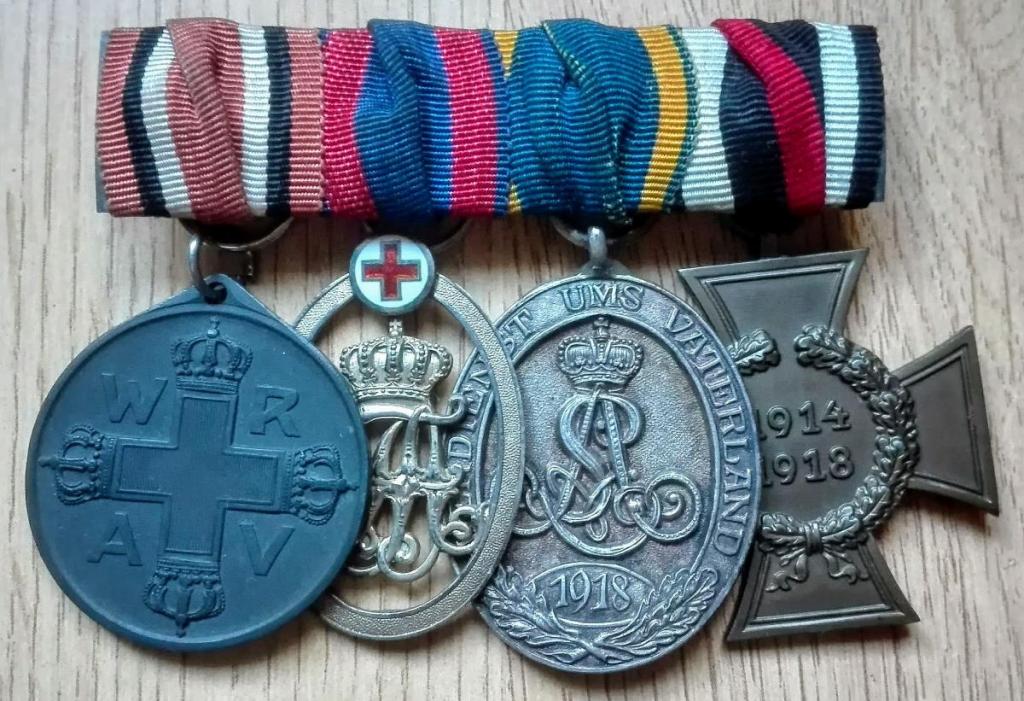

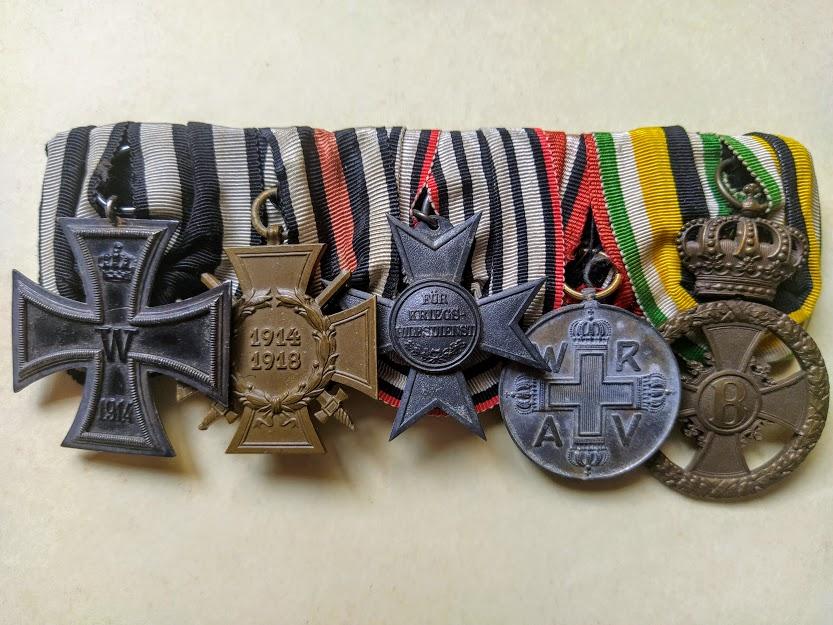
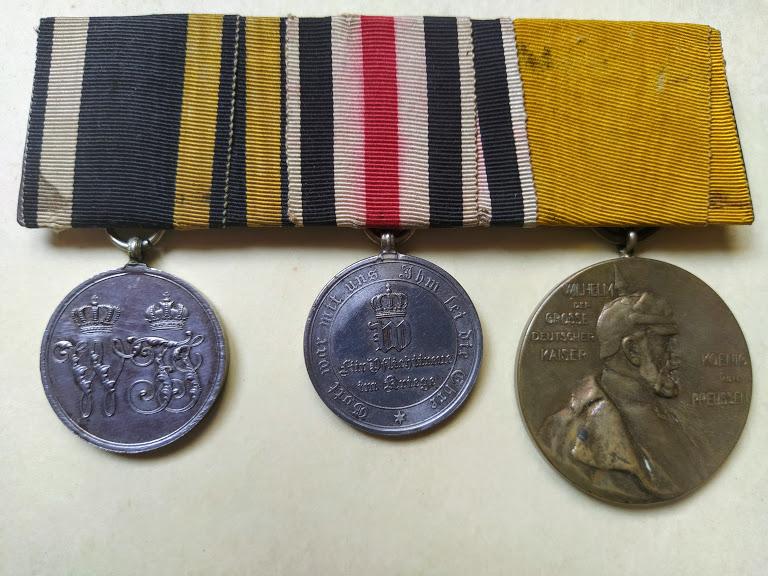
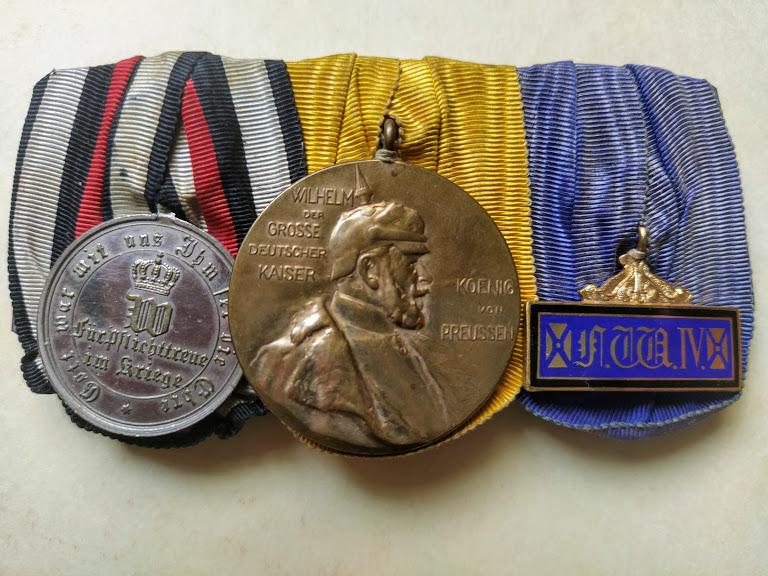
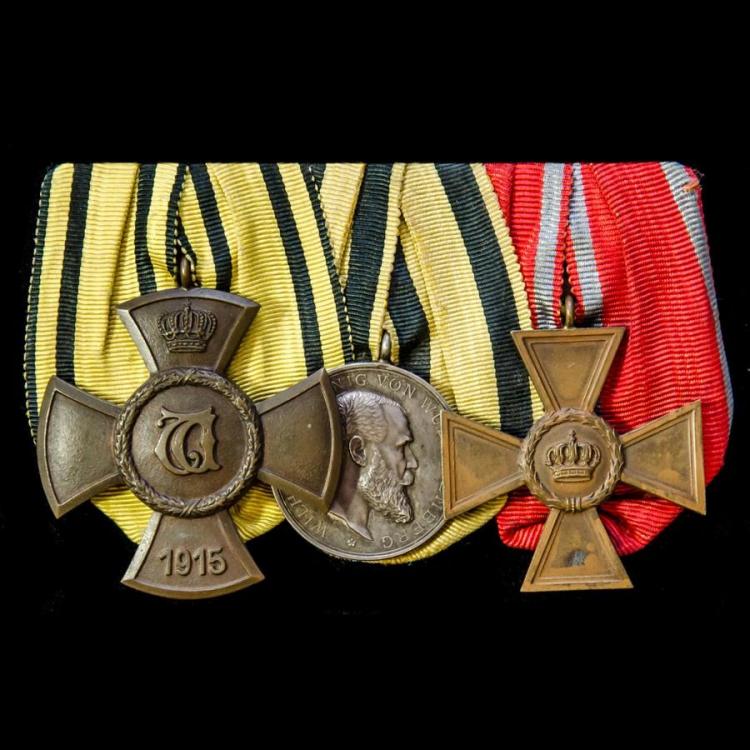
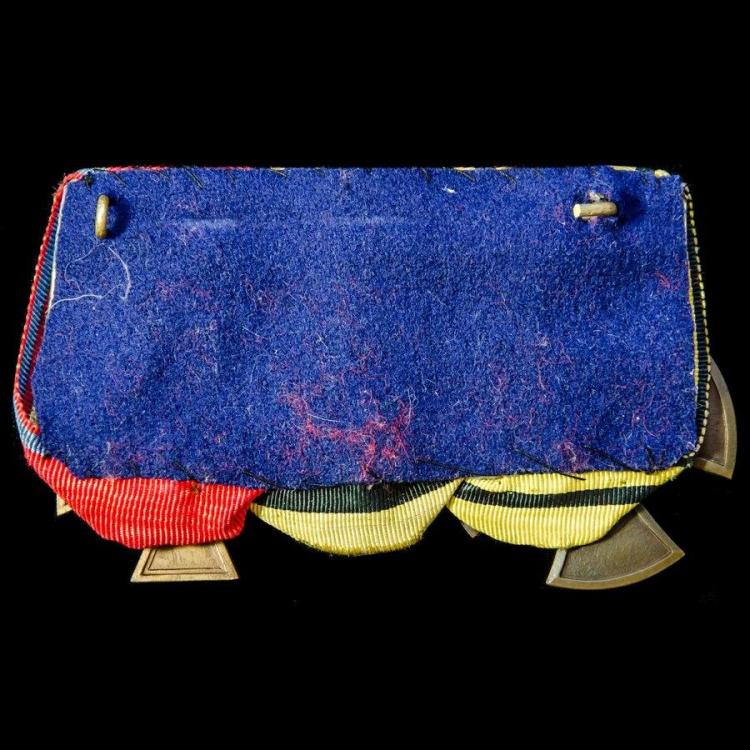
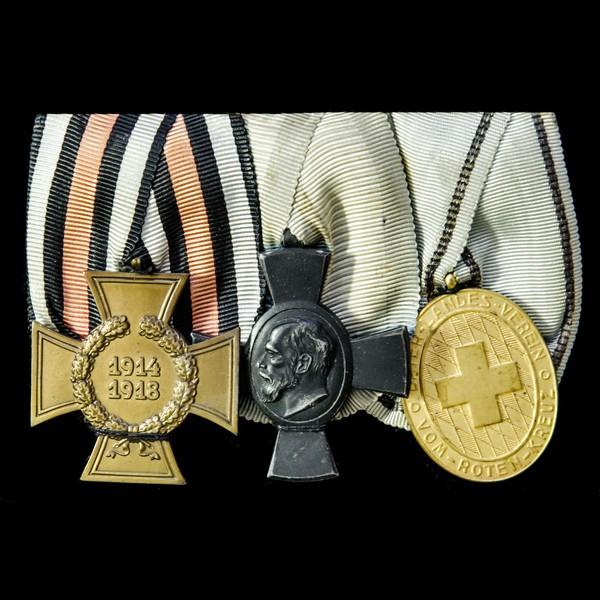
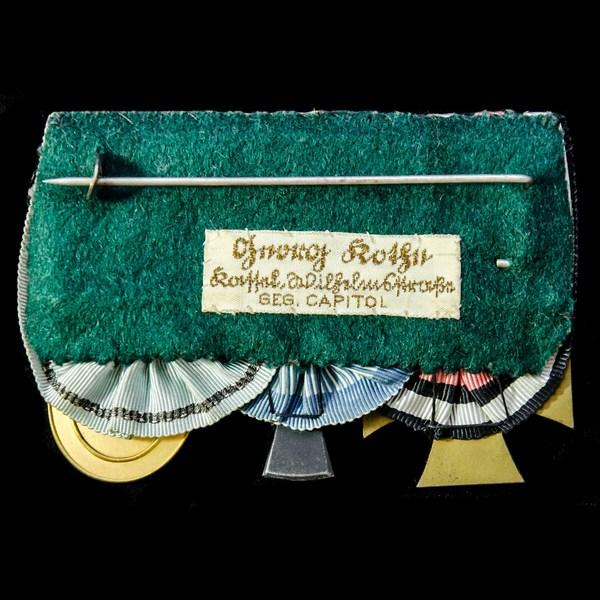
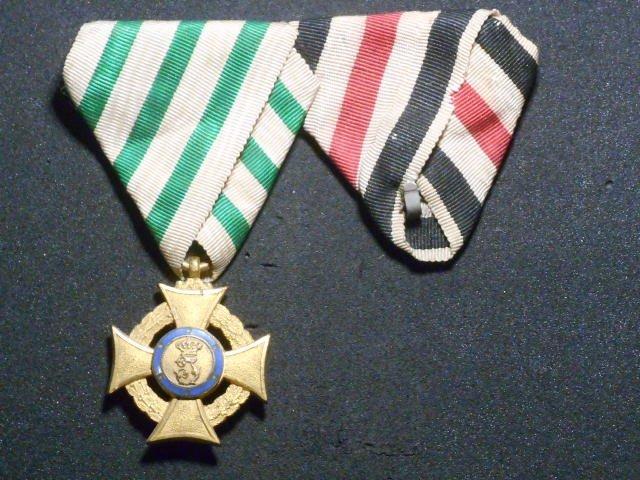
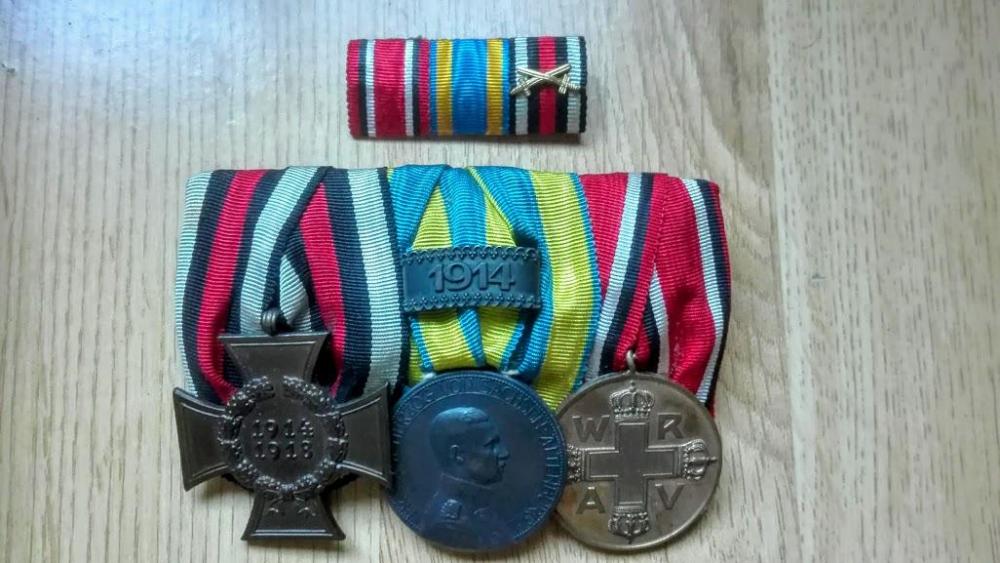


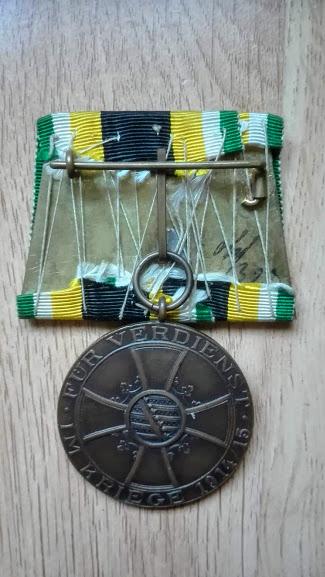
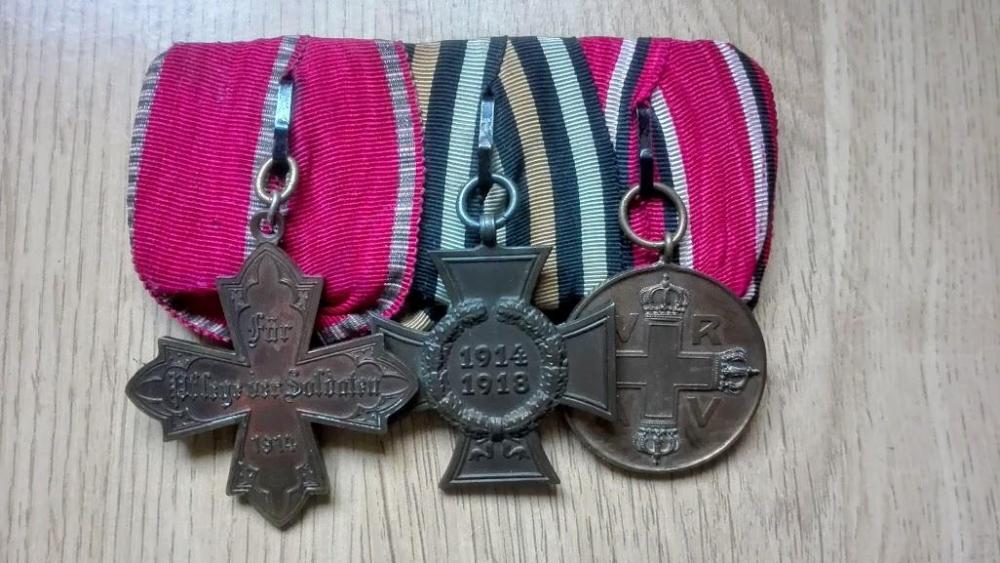
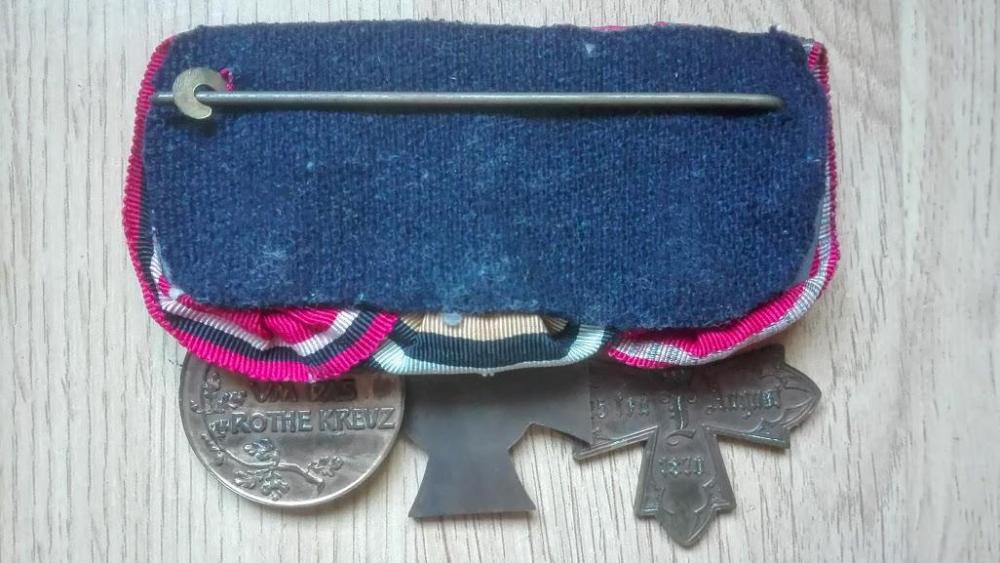
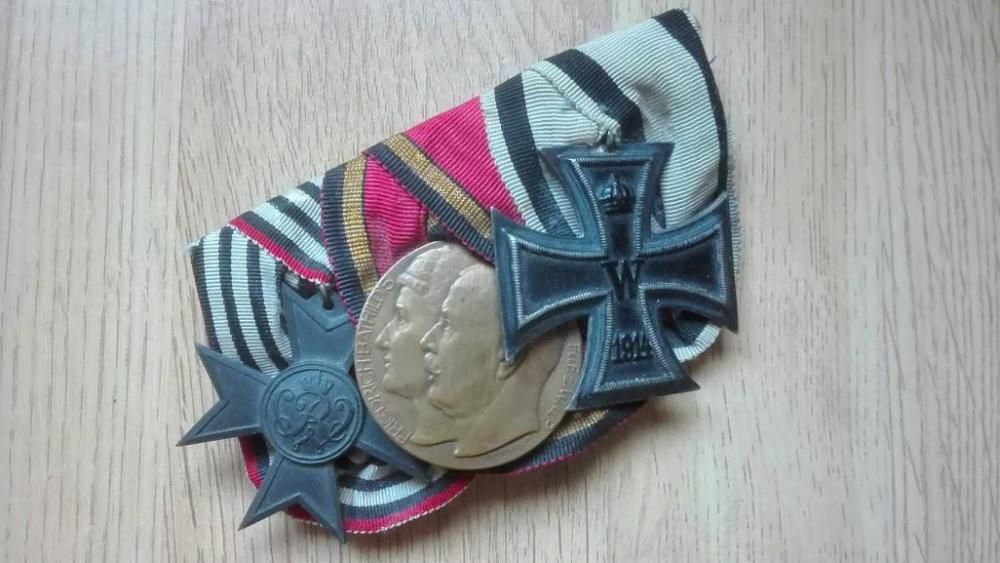

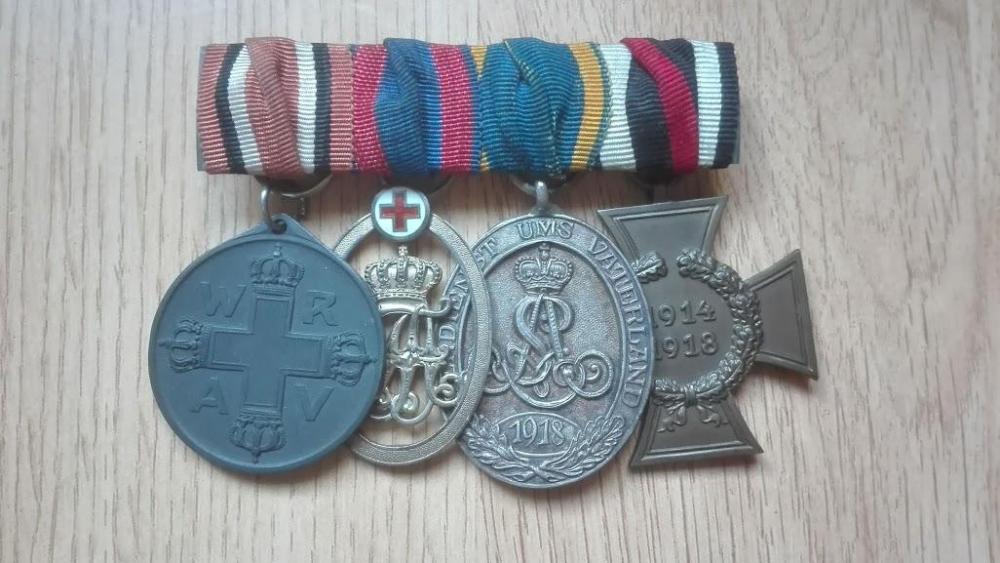
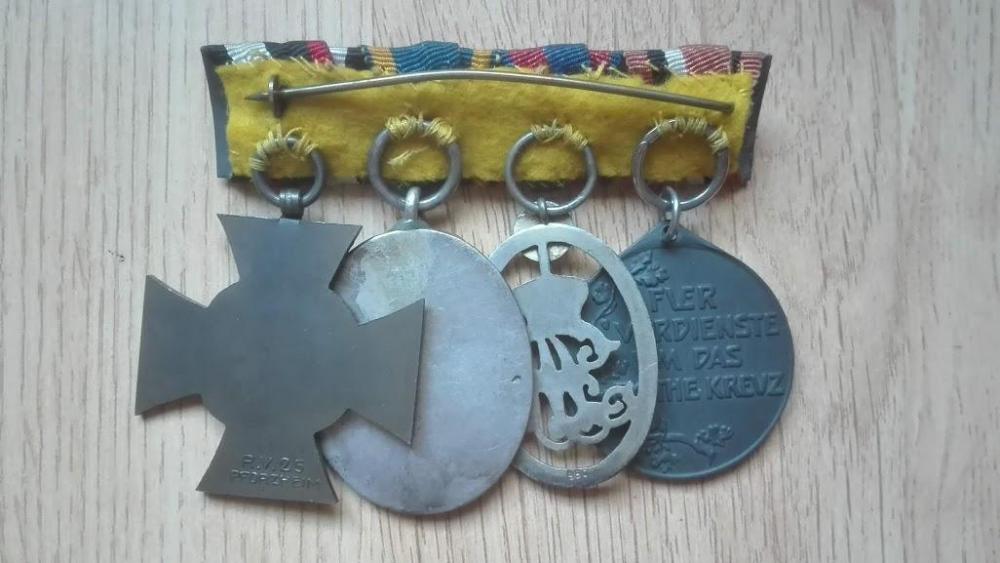
Oldenburg Awards
in Germany: Imperial: The Orders, Decorations and Medals of The Imperial German States
Posted
Thank you Wild Card for the source of the information - much appreciated! In 2013 Dave Danner had confirmed to me on this forum that a list of recipients of the Anna-Luisen Verdienstzeichen for each of the two Schwarzburg states exists in the archives. Maybe someday after this COVID matter is over...
Regards